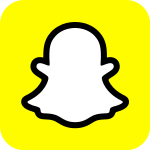
SnapChat
Snapchat is an American multimedia messaging app developed by Snap Inc. One of the principal features of Snapchat is that pictures and messages are usually only available for a short time before they become inaccessible to their recipients. As of December 2020, Snapchat had 265 million daily active users. On average more than 4 billion Snaps are sent each day.
History
Snapchat was created by Evan Spiegel, Bobby Murphy, and Reggie Brown, former students at Stanford University. According to documents and deposition statements, Reggie Brown brought the idea for a disappearing pictures application to Evan Spiegel because Spiegel had prior business experience. Brown and Spiegel then pulled in Bobby Murphy, who had experience coding. The three worked closely together for several months and launched Snapchat as "Picaboo" on the iOS operating system on July 8, 2011.
The app was relaunched as Snapchat in September 2011, and the team focused on usability and technical aspects, rather than branding efforts. One exception was the decision to keep a mascot designed by Brown, "Ghostface Chillah," named after Ghostface Killah of the hip-hop group Wu-Tang Clan.
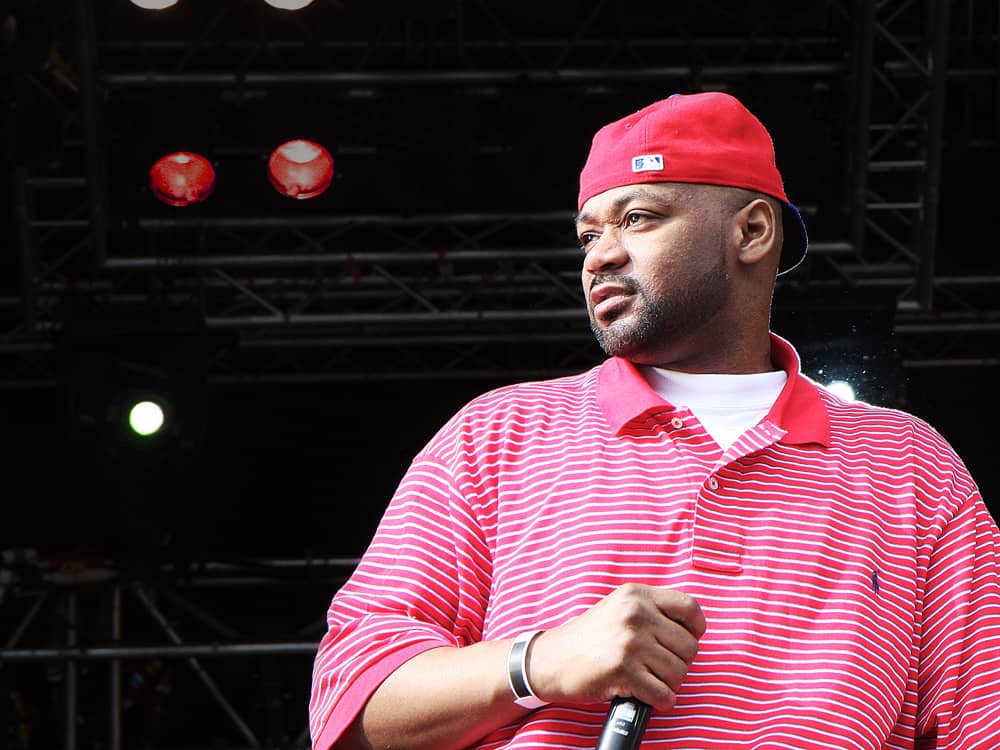
Snapchat was released as an Android app on October 29, 2012. In December 2019, App Annie announced Snapchat to be the 5th most downloaded mobile app of the decade. The data includes figures for iOS downloads starting from 2010 and Android downloads starting from 2012. Snapchat acquired AI Factory, a computer vision startup, in January 2020 to give a boost to its video capabilities.
Vision
In their first blog post, dated May 9, 2012, CEO Evan Spiegel described the company's mission:
"Snapchat isn’t about capturing the traditional Kodak moment.
It’s about communicating with the full range of human emotion — not just what appears to be pretty or perfect."
He presented Snapchat as the solution to stresses caused by the longevity of personal information on social media, evidenced by "emergency detagging of Facebook photos before job interviews and photoshopping blemishes out of candid shots before they hit the internet.
Different usage
From its earliest days, Snapchat's main demographic has consisted of the Generation Z age group. On the app store, the age classification is 12+.
Researchers from the University of Washington and Seattle Pacific University designed a user survey to help understand how and why the application was being used.
They found out that Snapchat is used for a variety of creative purposes that are not necessarily privacy-related at all. In the study, only 1.6% of respondents reported using Snapchat primarily for sexting, although 14.2% admitted to having sent sexual content via Snapchat at some point. These findings suggest that users do not seem to utilize Snapchat for sensitive content. Rather, the primary use for Snapchat was found to be for comedic content such as "stupid faces" with 59.8% of respondents reporting this use most commonly. The study results also suggested that Snapchat's success is not due to its security properties, but because the users found the application to be fun.
June 2013: Snapchat introduced Snapkidz for users under 13 years of age. Snapkidz was part of the original Snapchat application and was activated when the user provided a date of birth to verify his/her age. Snapkidz allowed children to take snaps and draw on them, but they could not send snaps to other users and could only save snaps locally on the device being used.
Advertising is now also utilizing AR lenses that make users a part of the advert. Coca Cola, Pepsi and Taco Bell are just a select few of the brands now utilizing the tech on Snapchat. Consumers no longer scroll past these adverts, but become a part of them with AR lenses.
2014: Snapchat introduced a new feature called Snapcash which spurred its popularity among adult content creators. Snapchat allows private premium accounts in which users can monetize their content. This feature is mostly used by models to monetize their adult content. Snapchat is increasingly becoming an integral part of the online porn industry.
September 2016: Snapchat Inc. was renamed Snap Inc. to coincide with the introduction of the company's first hardware product, Spectacles— smartglasses with a built-in camera that can record 10 seconds of video at a time.February 2017: Spectacles became available for purchase online.
Features
Snapchat is primarily used for creating multimedia messages referred to as "snaps"; snaps can consist of a photo or a short video, and can be edited to include filters and effects, text captions, and drawings. Snaps can be directed privately to selected contacts, or to a semi-public "Story" or a public "Story" called "Our Story."
December 2012: video snaps was added as a feature option in. A later update allowed the ability to record up to 60 seconds, but are still segmented into 10 second intervals.
May 2014: the ability to communicate via video chat was added.
Direct messaging features were also included in the update, allowing users to send ephemeral text messages to friends and family. The Snapchat app does not prevent screenshots from being taken but can notify the sender if it detects that it has been saved.
November 2014: Snapchat introduced "Snapcash," a feature that lets users send and receive money to each other through private messaging.
January 2015: Snapchat introduced "Discover" an area containing channels of ad-supported short-form content from major publishers, including BuzzFeed, CNN, ESPN, Mashable, People, Vice and Snapchat itself among
August 2015: To address data usage concerns, a "Travel Mode" option was added. When activated, the feature prevents the automatic downloading of snaps until they are explicitly requested by the user.
March 2016: Snapchat launched a major revision of the messaging functionality known as "Chat 2.0," adding stickers, easier access to audio and video conferencing, the ability to leave audio or video "notes," and the ability to share recent camera photos. The implementation of these features are meant to allow users to easily shift between text, audio, and video chat as needed while retaining an equal level of functionality.
July 2016: Snapchat introduced a new, optional feature known as "Memories."
Memories allow snaps and story posts to be saved into a private storage area, where they can be viewed alongside other photos stored on the device, as well as edited and published as snaps, story posts, or messages anytime. Snaps accessible within Memories can additionally be placed into a "My Eyes Only" area that is locked with a Personal identification number (PIN).
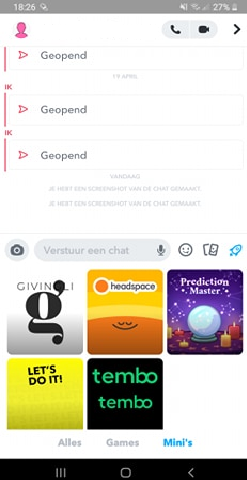
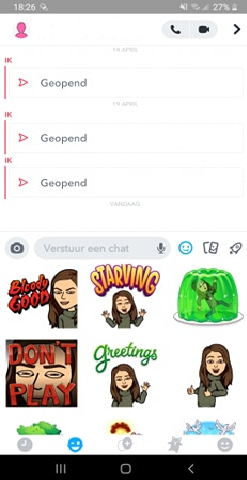
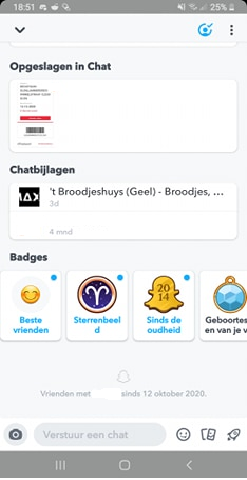
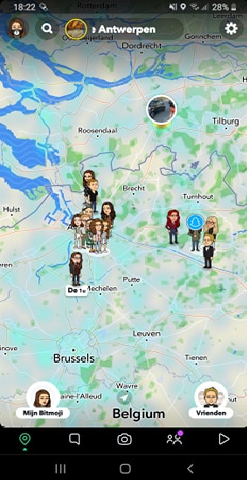
May 2017: an update made it possible to send snaps with unlimited viewing time, dropping the previous ten-second maximum duration, with the content disappearing after being deliberately closed by the recipient. New creative tools, namely the ability to draw with an emoji, videos that play in a loop, and an eraser that lets users remove objects in a photo with the app filling in the space with the background, were also released.
In June 2017: "Snap Map" was introduced, which allows users to optionally share their location with friends. A map display, accessible from the viewfinder, can be used to locate stories based on location data, supporting the use of Bitmoji as place markers. Entering a "Ghost Mode" hides the user from the map.
July 2017: Snapchat started allowing users to add links to snaps, enabling them to direct viewers to specific websites and added more creative tools: A "Backdrop" feature lets users cut out a specific object from their photo and apply colorful patterns to it in order to bring greater emphasis to that object, and "Voice Filters" enable users to remix the sounds of their voices in the snap.
June 2018: Snapchat added the feature of deleting a sent message (including; audio, video, and text) before it is read.
August 2018: Snapchat allows users to send Musical GIFs, TuneMojis.
January 2018 SnapChat introduced the use of end-to-end encryptionin the application but only for snaps (pictures and video), according to a Snapchat security engineer presenting at the January 2019 Real World Crypto Conference.
June 2020: Snapchat added Bitmoji's. Bitmoji are stickers featuring personalized cartoon avatars, which can be used in snaps and messaging. Bitmoji characters can also be used as World Lenses.
How to use?
To make a picture you press the photo button. If you want to add a filter press anywehere on the screen. By holding down on the photo button while inside the app, you can make a video. Now you can add effects:
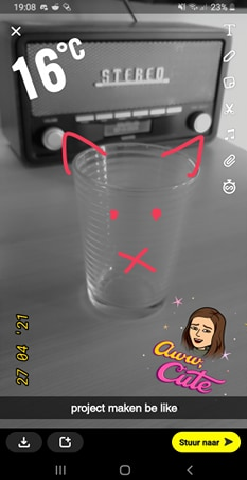
- The first button on the left (T): change text font, color and size.
- The second button on the left (crayon): draw or write text on your photo in different colors.
- The third button ont the left allows you to add stickers. (bitmoji/time/day/location related)
- The fourth button on the left allows you to cut parts of your picure.
- The fifth button on the left (music node): allows you to add music.
- The sixth button (paperclip): alows you to add a link.
- The last button on the left makes you change the time the snap is displayed by the reciever
Private message photo snaps can be viewed for a user-specified length of time before they become inaccessible. Snapchat doesn't stop screenshots but it gives the other user a notification of the made screenshot. However, these notifications can be bypassed through either unauthorized modifications to the app or by obtaining the image through external means. One snap per day can be replayed for free.
Friends can be added via usernames and phone contacts, using customizable "Snapcodes," or through the "Add Nearby" function, which scans for users near their location who are also in the Add Nearby menu. It's not only possible to make snaps or video's.You can also send messages. These messages you can save by clicking on them.
Private message photo snaps can be viewed for a user-specified length of time before they become inaccessible. Snapchat doesn't stop screenshots but it gives the other user a notification of the made screenshot. However, these notifications can be bypassed through either unauthorized modifications to the app or by obtaining the image through external means. One snap per day can be replayed for free. Friends can be added via usernames and phone contacts, using customizable "Snapcodes," or through the "Add Nearby" function, which scans for users near their location who are also in the Add Nearby menu. It's not only possible to make snaps or video's.You can also send messages. These messages you can save by clicking on them.
Appearance
As incentive to send content regularly, emoji icons will appear next to the names of contacts that the user frequently interacts with.
| Emoji | Name | Snapchat meaning |
|---|---|---|
| 💕 | Super BFF | Appears next to the user's number 1 Best Friend when they are also their number 1 Best Friend for two months in a row |
| Best Friend | (Best Friend Forever)Appears next to the user's number 1 Best Friend when they are also their number 1 Best Friend for two weeks in a row. | |
| Besties | Appears next to the user's number 1 Best Friend when they are also their number 1 Best Friend. | |
| 😊 | BFs | Appears next to one of the user's Best Friends. |
| 😬 | Mutual Besties | Appears next to someone when the user's number 1 Best Friend is also their number 1 Best Friend. |
| 😎 | Mutual BFs | Appears next to someone whom the user shares a best friend with |
| 🔥 | Snapstreak | Appears next to the number of days that the user and a friend have Snapped each other. If the user and their friend do not both send a Snap within 24 hours, they will lose their Snapstreak |
| ✨ | Group Chat | Appears next to all of the user's group chats. |
| ⌛ | Hourglass | Appears next to someone's name if the user's Snapstreak is going to end soon. |
| 🎂 | Birthday Cake | Appears next to someone when it is their birthday. |